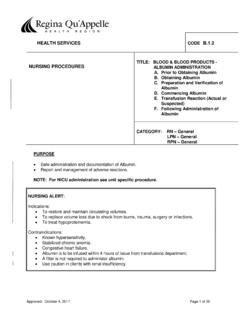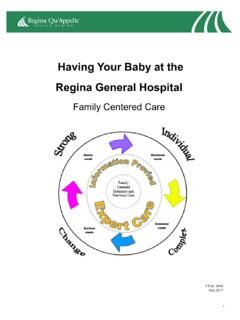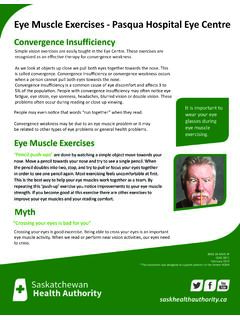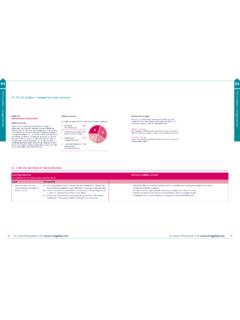Transcription of BETTER - Saskatchewan Health Authority
1 BETTER . EVERYDAY. Visual management 2015. Regina Qu'Appelle Health Region Table of Content Introduction ..3. Daily Huddles .. 3. Cascading Huddles ..4. Daily stat sheet .. 5. Visibility Walls .. 6. Daily 6. Performance Indicators (QCDSE) .. 7. Improvement Ideas: BETTER Every Day .. 8. Setting SMART Targets .. 9. Key Things to 10. Level of Implementation: From Wallpaper to Kaizen .. 11. 1. Managing Your Daily Work .. 11. 2. Creating and Following Standard Work .. 12. 3. Using the Visibility Wall to Drive Improvement Work .. 12. What Is Your Score? .. 12. References .. 13. Resources .. 13. Glossary of Terms .. 14. Appendix I: Daily Huddle Standard Work Example .. 15. Weekly Huddle Standard Work Example ..16-17. Appendix IV: Daily Stat Sheet Example .. 18. Appendix V: Coaching by the Visibility Wall ..19-20. Appendix VI: Visual management Level of Implementation .. 21. Scoring Tool Document.
2 22. For more information contact: Kaizen Promotion Office Regina Qu'Appelle Health Region 2180 Victoria Avenue East 2nd Floor Regina, Saskatchewan S4N 7B9. Phone: 306-766-0797. Richelle Hahn, Daily Visual management Specialist, KPO. Phone: 306-766-0798. E-mail: Acknowledgement: John Black and Associates, LLC is facilitating deployment of the Saskatchewan Health Care management System. 2. Introduction Most teams in the Region have some experience with daily visual management ; they have a visibility wall and are doing regular huddles around it. Many teams are finding great value in this process, reporting huge improvements in team communication and cannot imagine going back to doing things the old way' again. However, other teams are still struggling to make visual management a natural part of their daily routine. Deciding on what metrics to track can be difficult and daily huddles can quickly turn into lengthy team meetings with loss of staff attention and buy-in.
3 Even though the visibility walls and huddles should be driven by the team, in many areas, huddles are not happening when the managers are not around. In general many teams still have opportunity to improve so that visibility walls and huddles are used to their fullest potential as a tool to manage the daily work and to make daily improvements. The purpose of the toolkit is to: Describe the ideas behind conducting daily huddles and the connection with visibility walls. Provide tips and ideas and key things to remember about visual management . Outlining the key steps in having a fully implemented visual management system. Daily Huddles The purpose of a huddle is to manage your daily work, to know how you are doing, to surface concerns (safety, quality, cost etc.), identify defects in Huddles are rapid and used for efficient the daily flow that affect staff, physicians, or the people we serve.
4 Communication and basically improve communication and create a culture of making daily accountability. improvements. It is a Huddle, Not a Meeting Investing 5-10 minutes a day to share safety concerns, priorities, issues and victories as a group can provide big payoffs with accelerated execution and increased efficiency. Take advantage of having the entire team's attention and use the huddle to identify areas of improvement. Remember, the huddle is about sharing information, not problem solving. If a bigger problem arises that requires more than 2-3 minutes, the discussion should be moved offline for the necessary parties. Make sure you start and end on time; it is a good idea to have a time keeper at the huddle. Keeping time is not to cut people off but to respect people's time; if the huddle starts to go longer than 15 minutes, people will drop the habit. Consider How long are your team huddles for the most part?
5 How long are they scheduled to be? 3. Return on Investment When beginning to implement daily huddles, immediate pushback can include hearing We are too busy or We don't need a meeting when we are seeing each other all day long . Yet, routine and standard work actually sets a team free; teams that huddle daily find they interrupt each other considerably less the rest of the day. There is a fixed time when everyone knows they'll have everyone else's attention. Meeting daily also clears up issues that otherwise linger to clog up the weekly or monthly meeting. The daily huddles are particularly key when departments or units are the busiest and spread the thinnest; it ensures the team knows the priorities and is equipped to keeping their daily tasks aligned with the plan. And it helps keep the morale high in the difficult times. Don't forget that it is possible to do a virtual huddle' over the phone.
6 Daily or Weekly Huddle How often a team needs to huddle around the visibility wall depends on what type of operation the department or unit is running. When working in a 24/7 operation, a huddle at each shift change is often a good idea. For Monday to Friday, operations, daily huddles may not be necessary, but everyone should huddle at least weekly. Decide on a huddle schedule that makes sense for the work being done. Try something for a couple of weeks to see how it is working. It can also be beneficial to huddle if there are major changes in the work area or if a safety issue occurs, so the team can resynchronize their efforts, coordinate, communicate and flexibly adapt to the current situation. Consider Do you experience situations where it would be useful to pull the team together for a quick huddle? Staff Should Lead Once a team becomes familiar with the routine of daily huddles, it is a good idea to have different staff members leading the huddle.
7 Having standard work for the huddle (see below) should make it possible for every team member to take turns facilitating it. This creates engagement and a sense of ownership . the huddle should not be just for the sake of the manager or supervisor, but for the entire team. This also means that even though the manager or supervisor is not present ( on the weekends, at a different site or on evenings) the huddles should still take place. Consider How often does your staff lead the huddle? See Appendix I for an example of standard work for a daily huddle. Cascading Huddles Once departments become familiar with daily huddles, the next step is implementing daily cascading huddles. Daily cascading huddles is a process that gives the leaders at the different levels in the organization a pulse-check as to what is happening in a department or unit that may impact other departments or the entire organization.
8 For example, the number of patients waiting in the Emergency Department for an inpatient bed, or an illness outbreak on a unit, or broken equipment or environmental conditions that could affect the services provided or constitutes a risk to our patients or staff. Daily cascading huddles enables leaders to react in a timely manner to any problems arising and to escalate what cannot be solved to a higher level. 4. For the cascading huddles to be effective, they must follow a standardized process. Every team and leader needs to know exactly what type of issues must to be escalated to the next level and in which manner. Figure 1 illustrates how a cascading schedule can work in an organization. Figure 1 Example of a cascading huddle schedule Staff huddle with Managers huddle Directors huddle VPs huddle with manager with director with VP CEO. After the morning huddle with the team, all the managers in one area participate in a 10 minute phone conference with their director.
9 Here, they share pertinent information with the other managers and the director, such as safety concerns, staffing levels, and issues that can impact services. Managers from other areas do the same with their directors. After this huddle, the directors huddle in a 10 minute phone conference with their Vice President, share information that needs to be shared to be able to manage their operation and escalate concerns to be dealt with at a higher level in the organization. Directors from other areas do the same with their VPs. The final huddle is the VPs with the CEO, where the VPs escalate any information they have received through the previous huddles. In this example, within less than one hour the CEO will have knowledge of the status of the entire organization. There is also an option of adding service teams to the huddles to address immediate inquiries related to labor relations, infection control, finance, and facilities, etc.
10 Daily cascading huddles is an extremely effective and powerful way of communicating concerns and issues through a large organization and ensures leaders have the pivotal information to make decisions and respond in a timely manner to a situation that otherwise might have turned into a crisis situation. Consider What would daily cascading huddles look like in your area? How would you benefit from connecting with other leaders every day to inform your work? How often do you experience problems that could have been prevented or minimized with more efficient communication? Daily stat sheet A daily stat sheet can be used during the cascading huddle to capture the information flow between the different teams and levels of the organization. Often a lot of the information on the visibility wall is also what should be captured on the daily stat sheet. Most often the visibility wall does not contain historical data for the daily metrics keeping them means running out of wall space.










